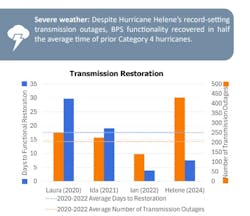NERC Report: North American Grid Reliable in 2024, Though Emerging Risks Pose New Challenges
The North American Electric Reliability Corporation (NERC) released its 2025 State of Reliability (SOR) report, which concludes that the North American bulk power system (BPS) remained reliable and resilient throughout 2024. According to the report, the system has seen measurable improvements in outage severity and duration, as well as faster restoration times. These trends reflect progress in mitigating traditional reliability risks.
However, the report also notes that new and emerging risks — such as extreme weather, large-scale load growth, and the evolving operational characteristics of inverter-based resources (IBRs) — are introducing new challenges for grid operators and planners.
Extreme weather continued to be the primary driver of major disruptions. In 2024, the United States experienced 27 weather-related events and Canada three, each resulting in damages exceeding $1 billion. Despite the high impact of two winter storms and five hurricanes, no operator-initiated load shedding occurred, a change from similar past events. NERC attributes this to improvements in grid planning, weatherization, and response protocols.
The report highlights reliability concerns tied to the rapid deployment of large energy-intensive facilities such as data centers. One 2024 incident saw roughly 1,500 MW of load disconnect suddenly from the system due to a transmission fault, which NERC compares in scale to an unexpected nuclear unit trip. NERC is continuing to assess these dynamics through its Large Loads Task Force and Load Modeling Working Group.
Approximately 45 GW of new IBR capacity was added to the BPS in 2024. However, issues with ride-through capability and inaccurate modeling of IBRs remain a reliability concern. NERC’s analysis of 10 major disturbances since 2016 found nearly 15 GW of unexpected reductions in IBR output, with most occurring between 2020 and 2024. In response, NERC issued a Level 3 Alert in May 2025 calling for improved modeling and performance standards for IBRs.
Areas with significant battery energy storage system (BESS) deployment, including Texas, saw signs of improved performance. Texas reached over 10 GW of BESS capacity by the end of 2024, with 19 GW more planned by the end of 2025. NERC observed instances in which batteries provided up to 100% of frequency regulation services in ERCOT. While challenges remain with the growing use of these systems, early findings suggest that with proper regulatory frameworks and technical implementation, BESS can contribute meaningfully to grid stability.
